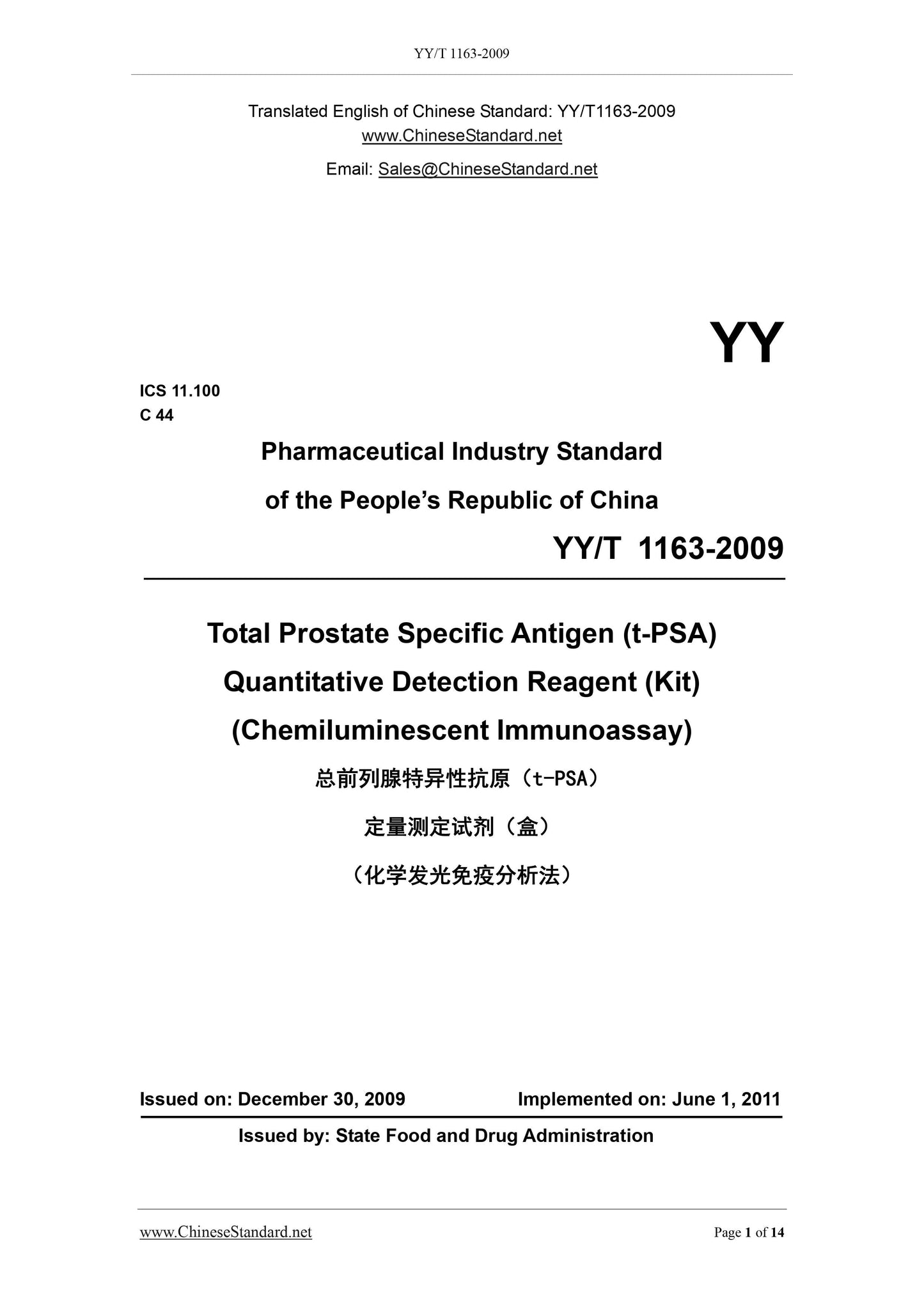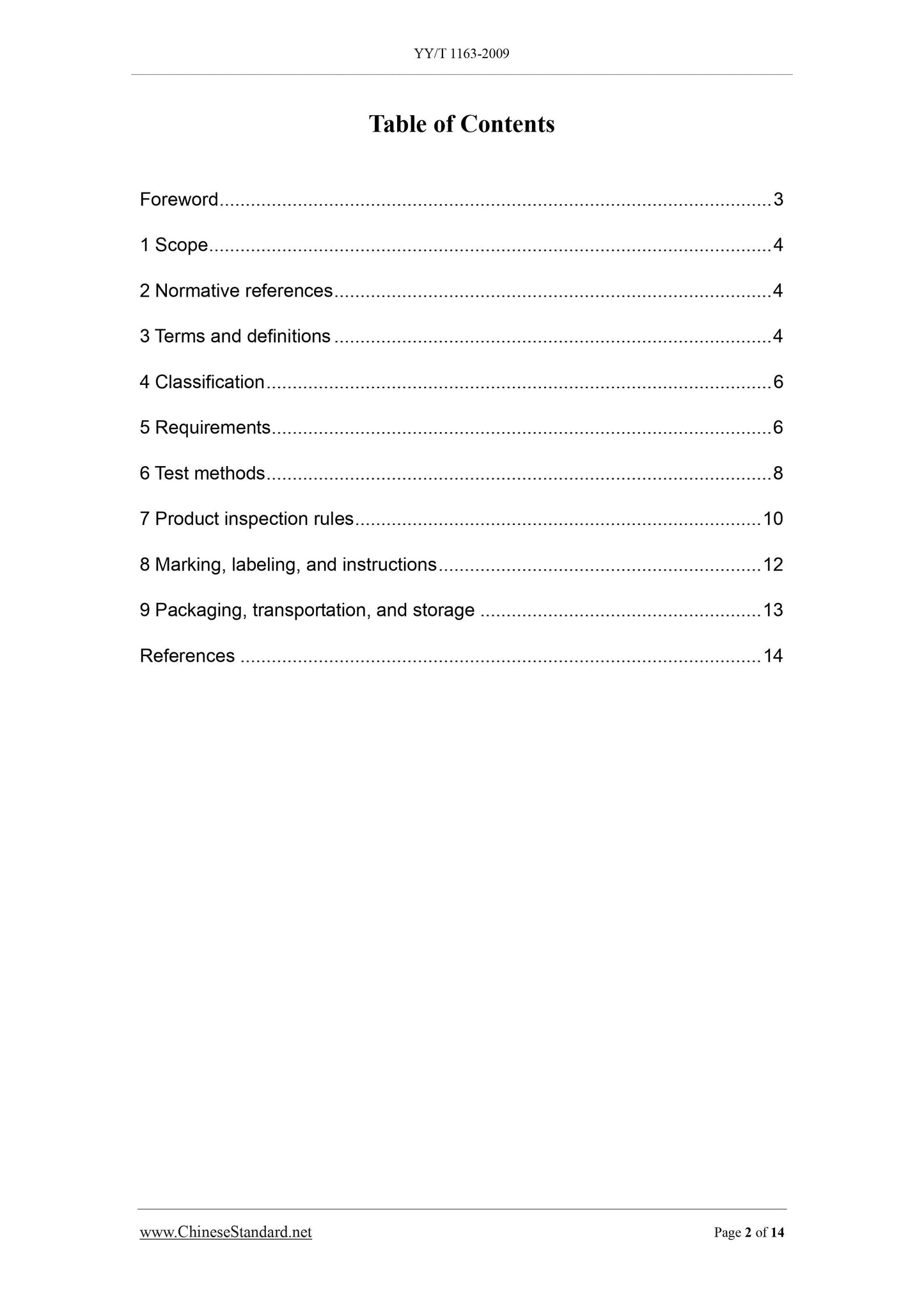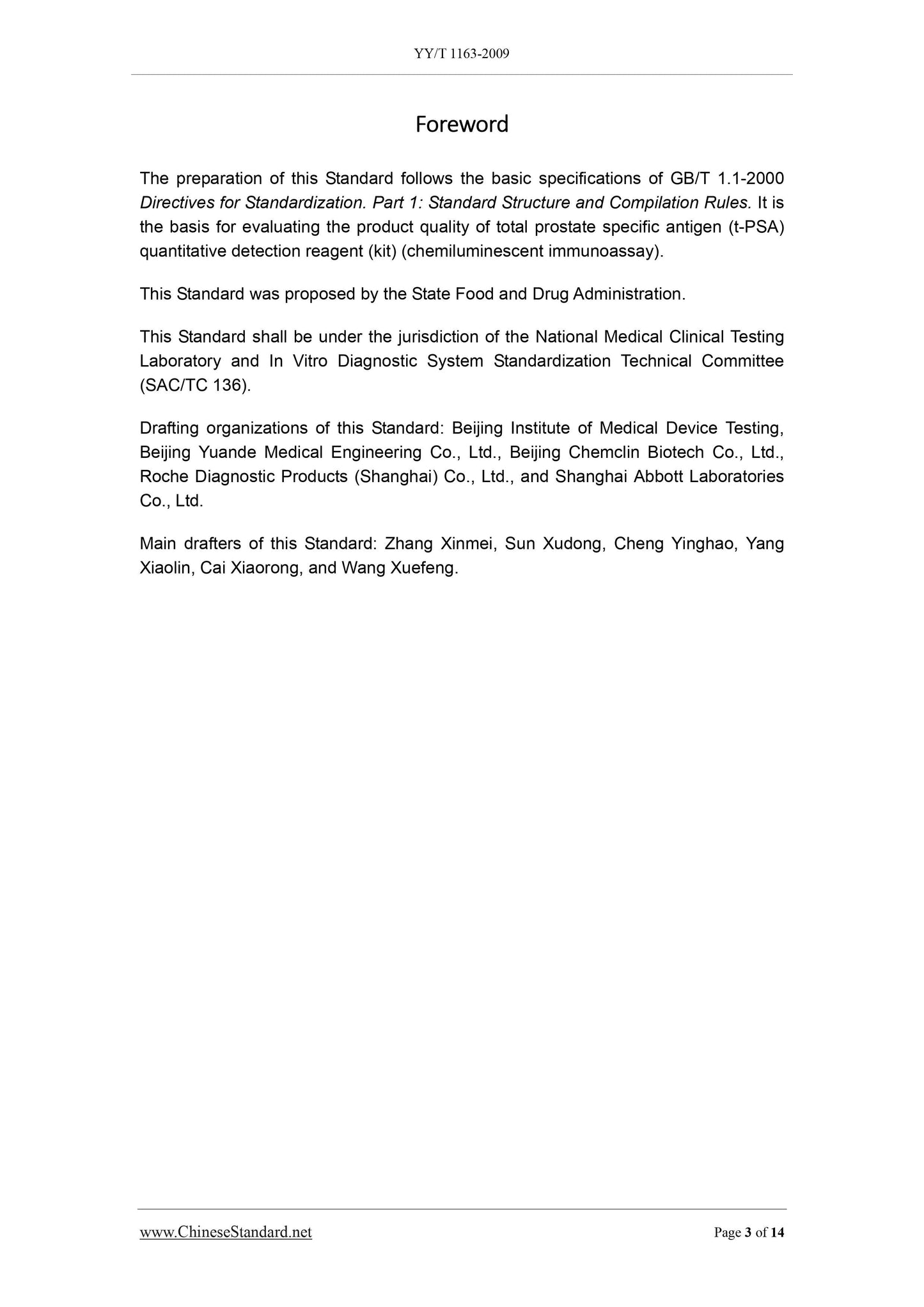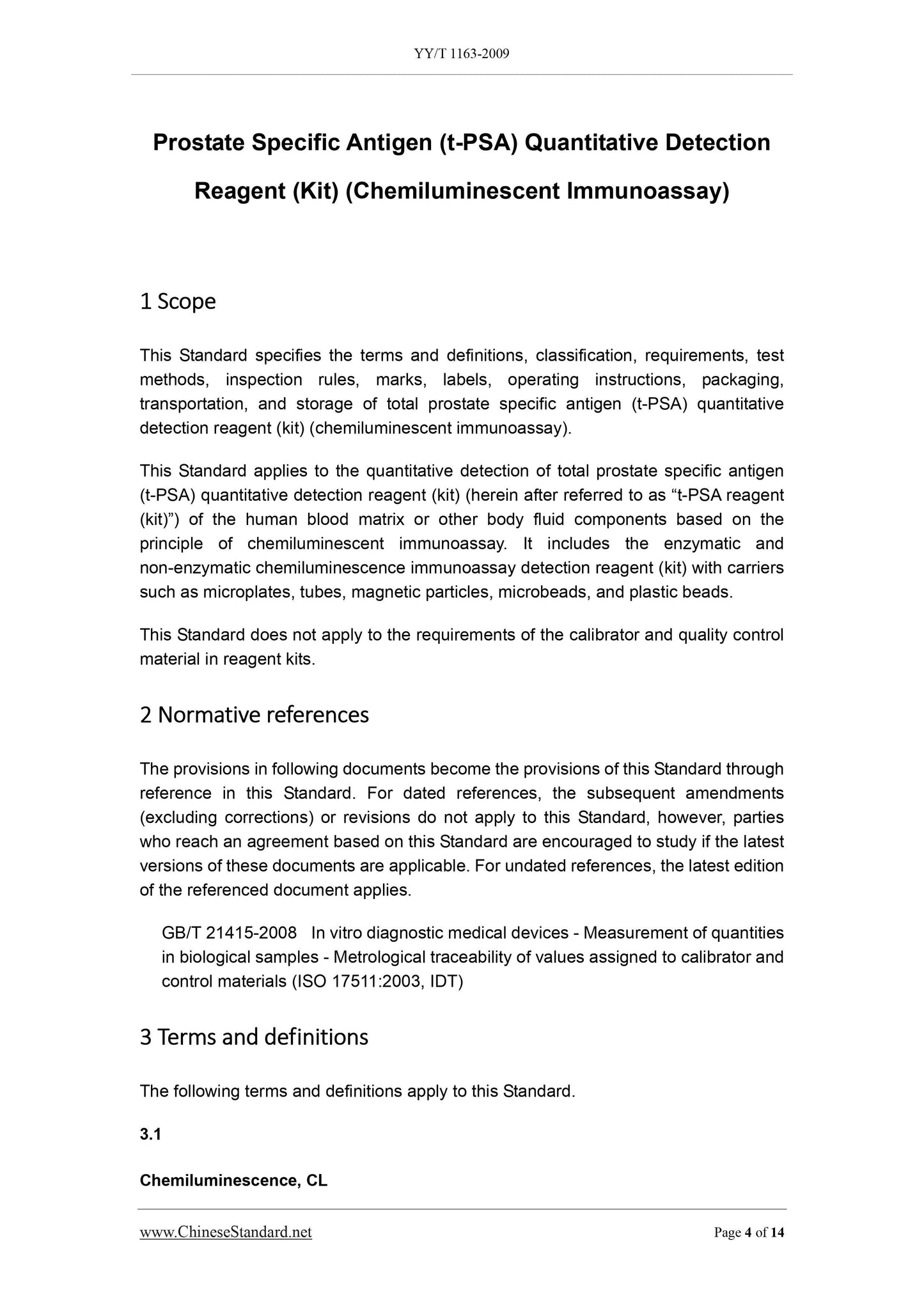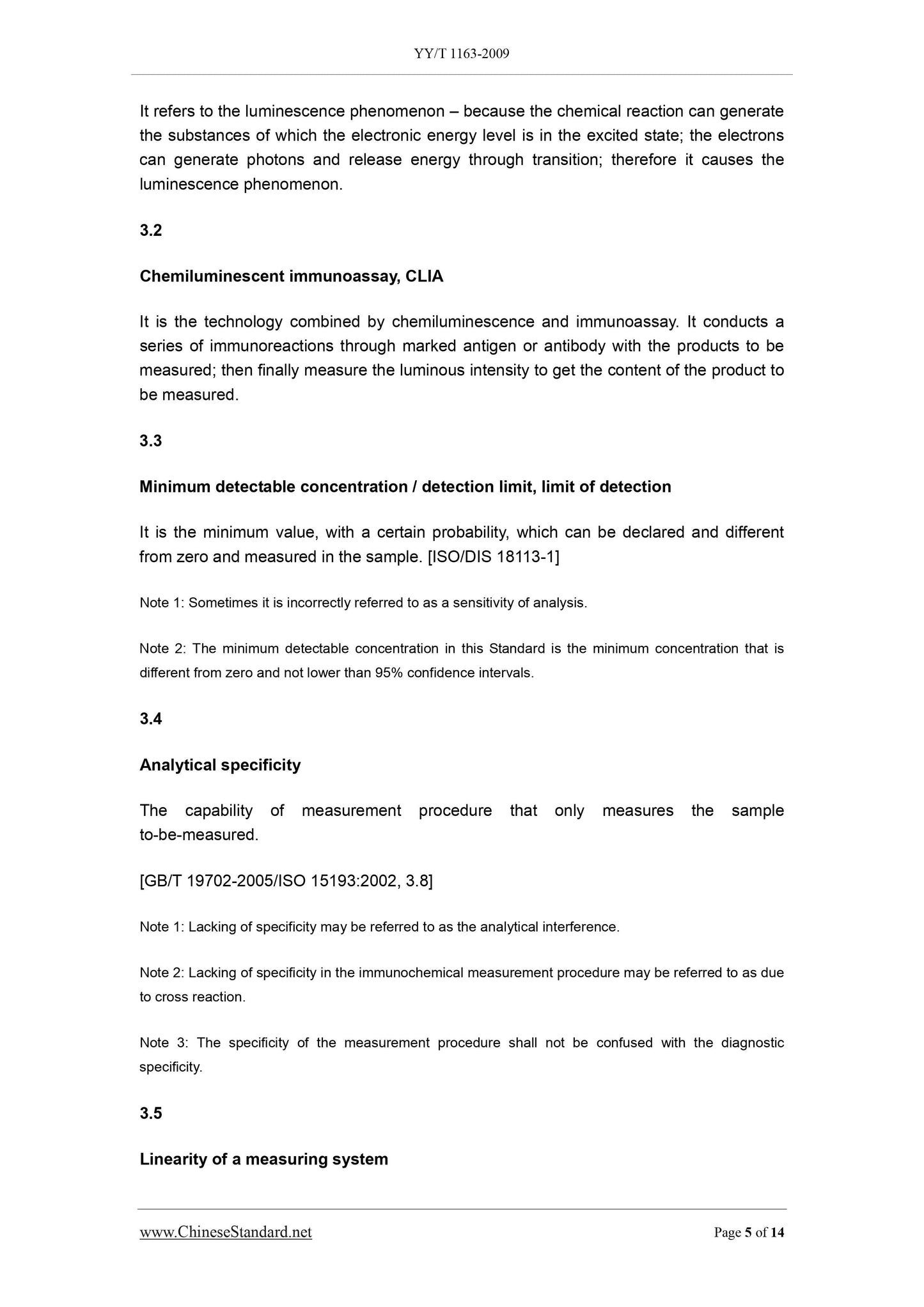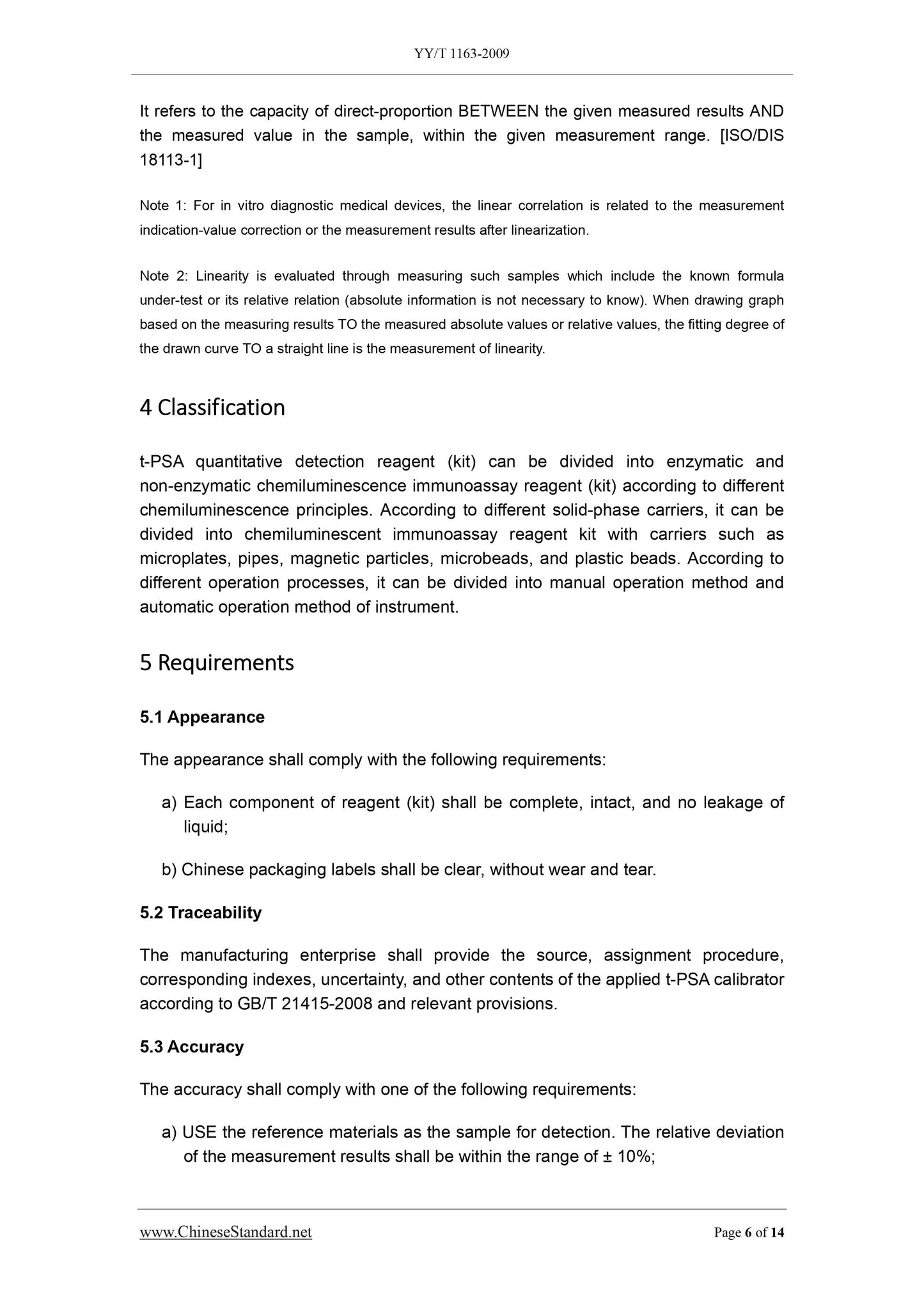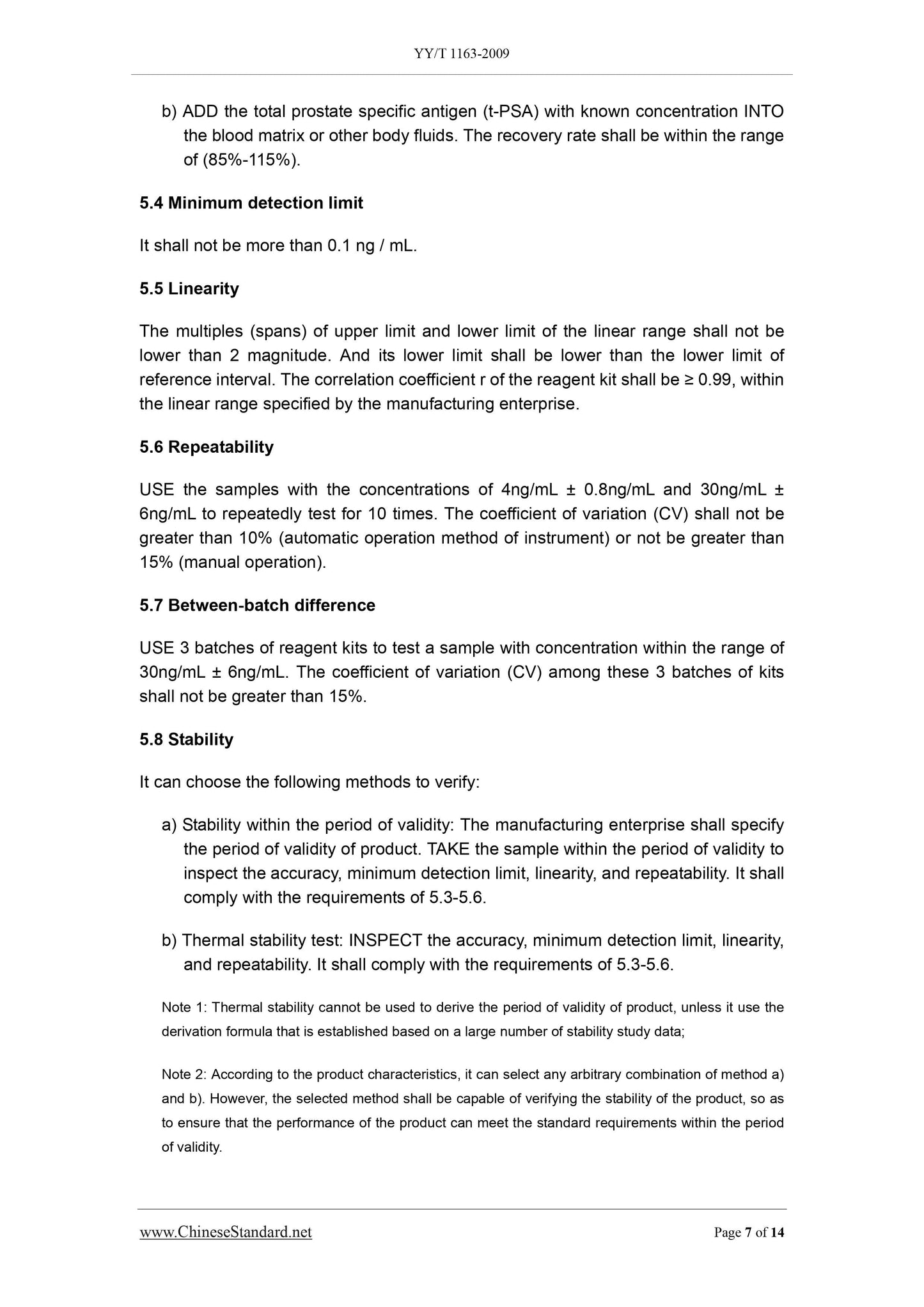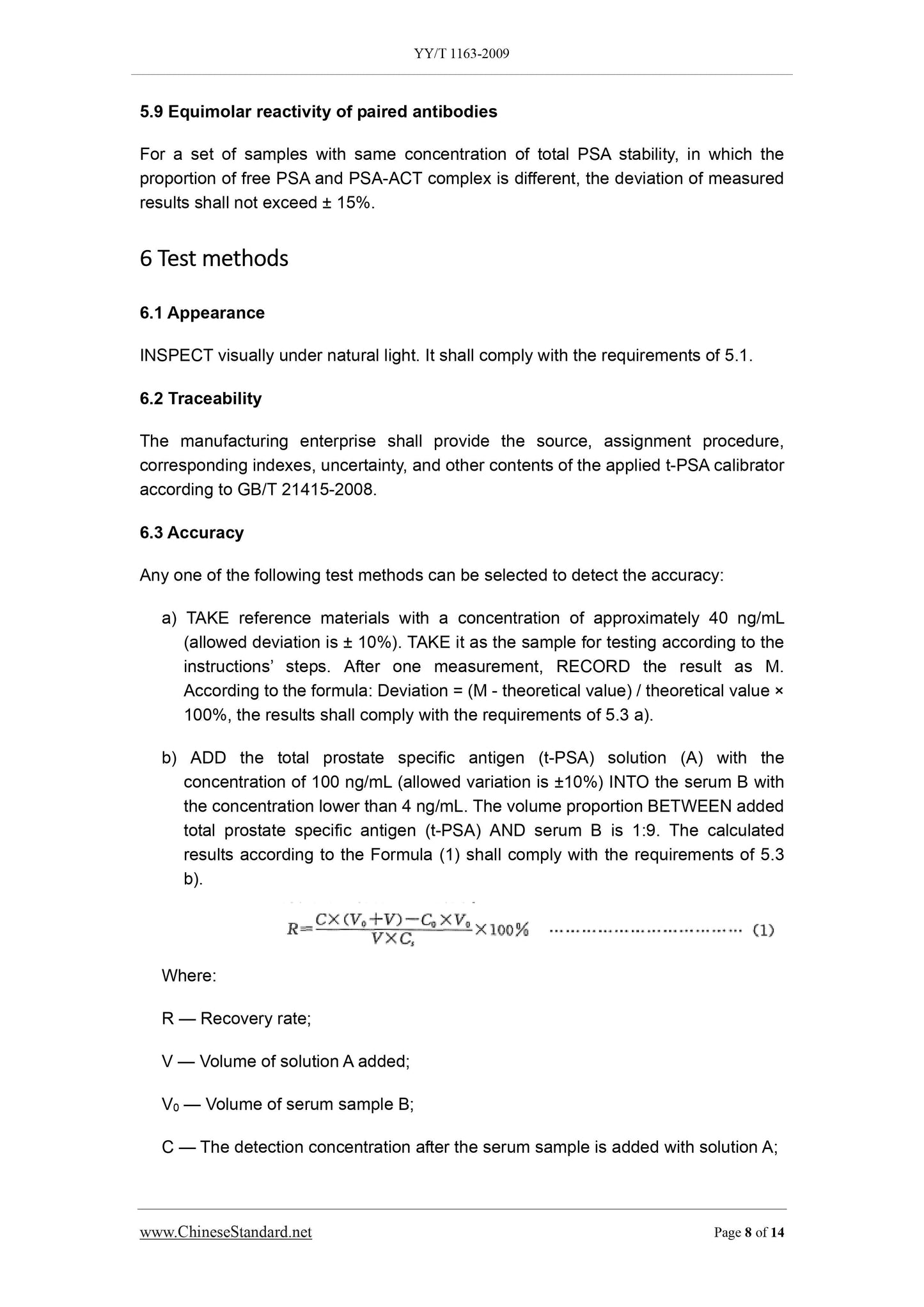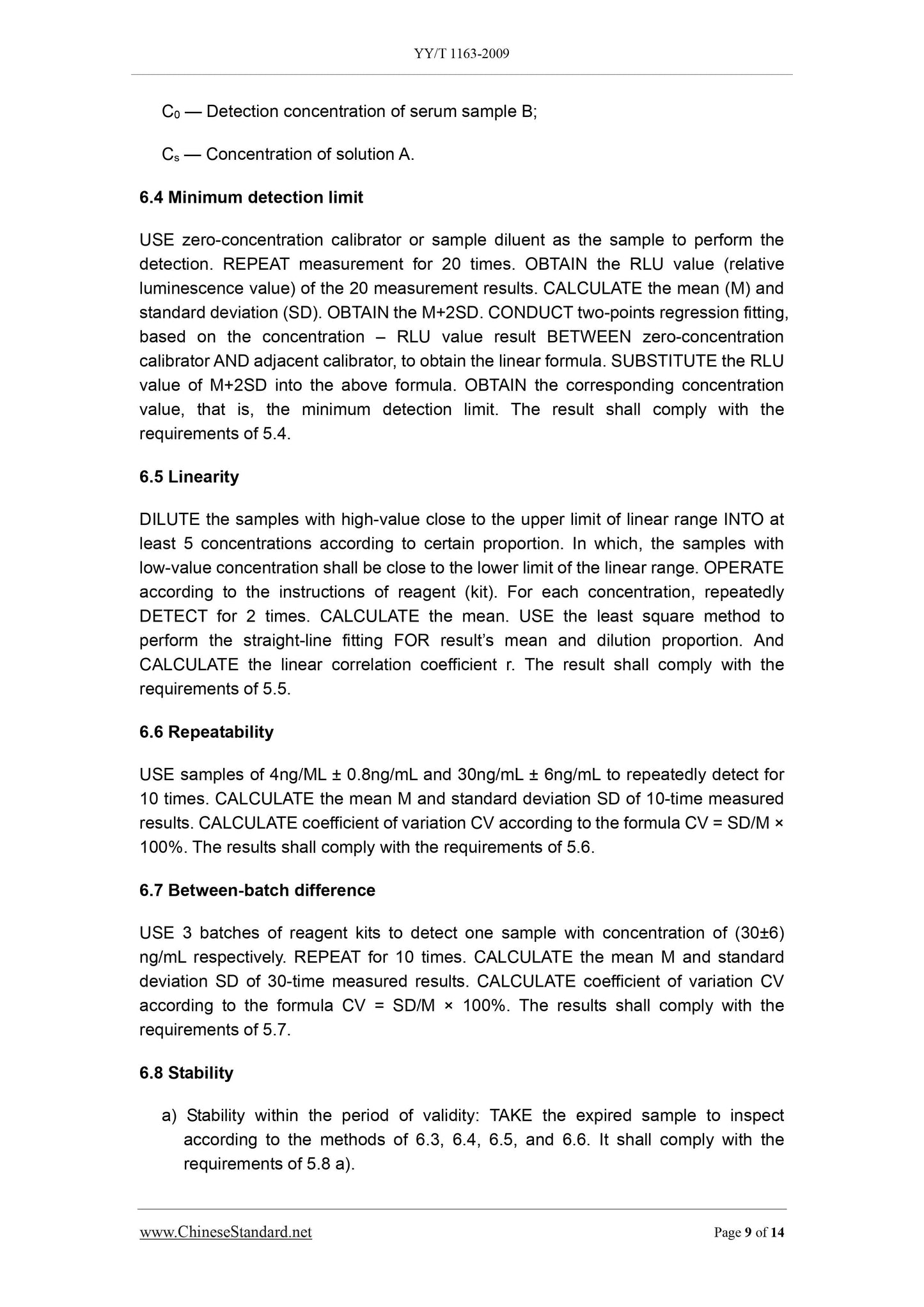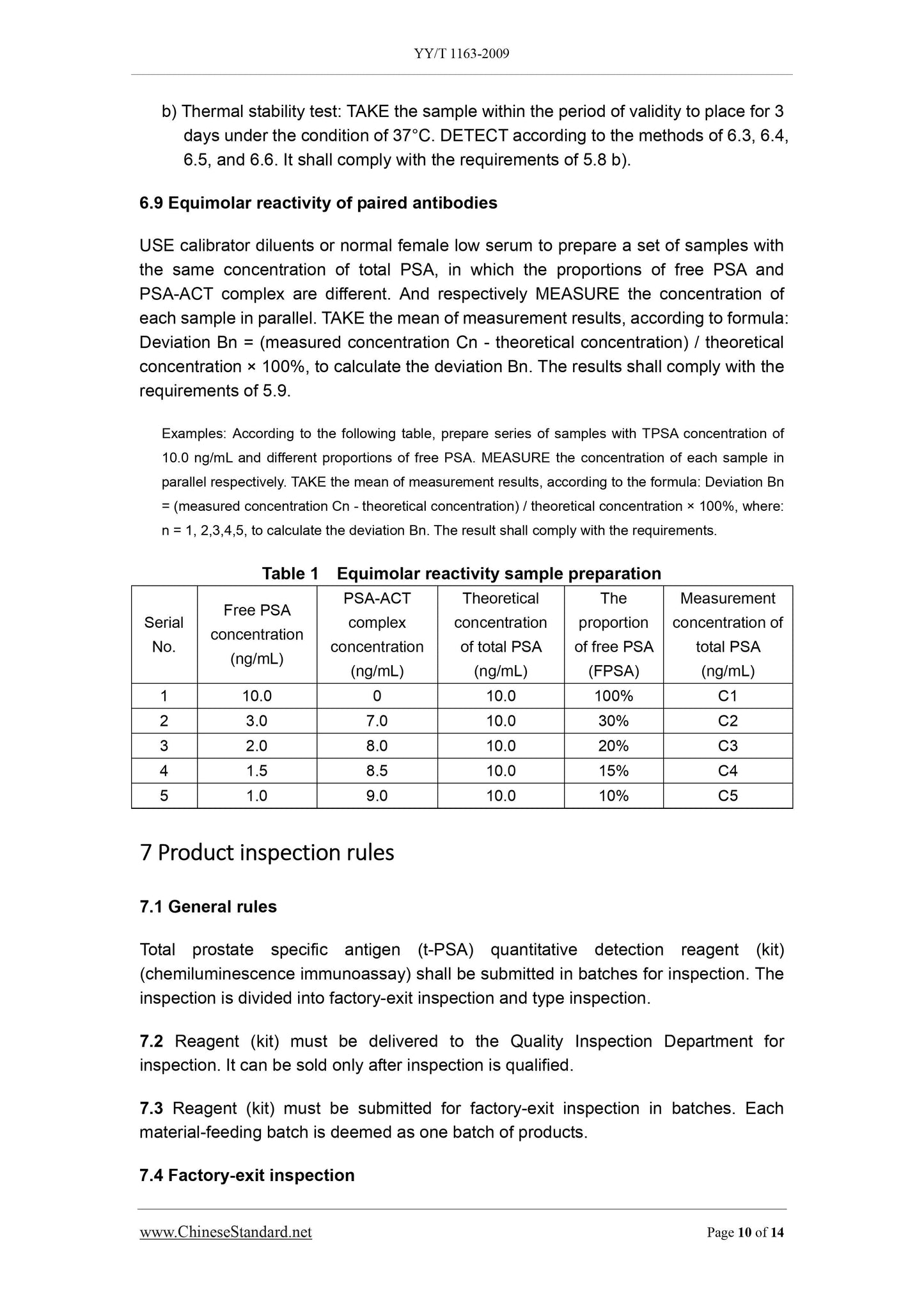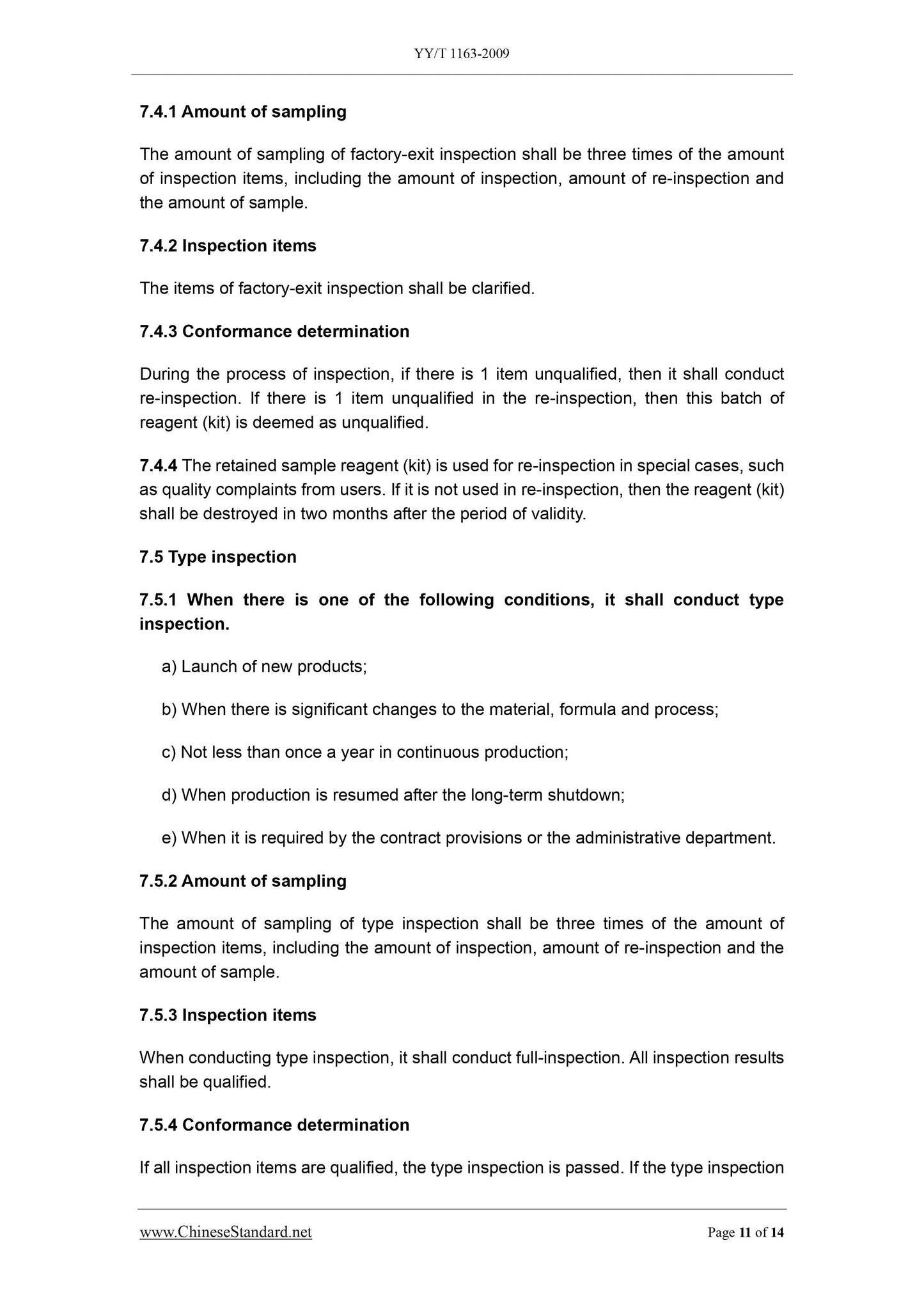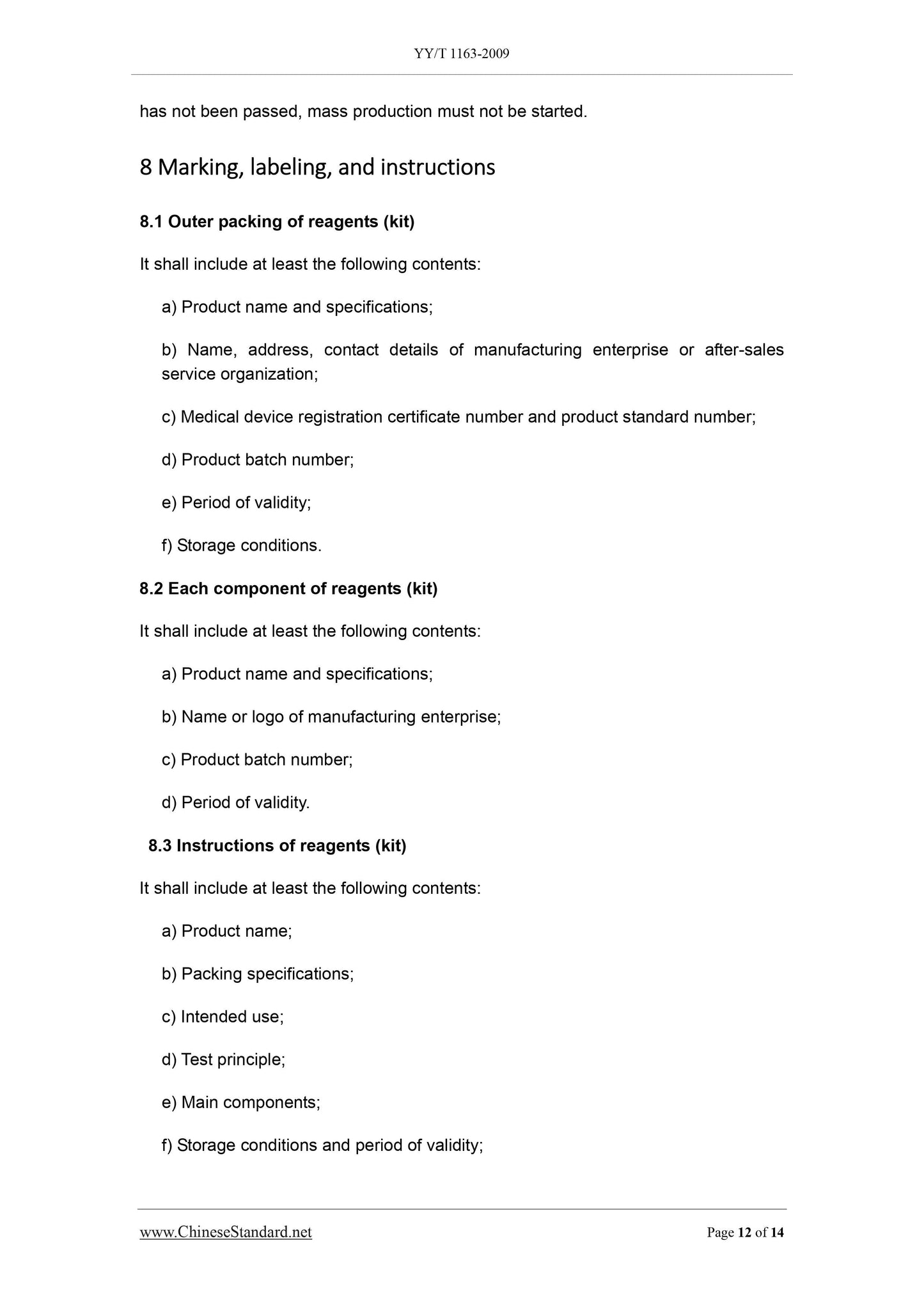1
/
of
12
PayPal, credit cards. Download editable-PDF & invoice in 1 second!
YY/T 1163-2009 English PDF (YYT1163-2009)
YY/T 1163-2009 English PDF (YYT1163-2009)
Regular price
$140.00 USD
Regular price
Sale price
$140.00 USD
Unit price
/
per
Shipping calculated at checkout.
Couldn't load pickup availability
Delivery: 3 seconds. Download true-PDF + Invoice.
Get QUOTATION in 1-minute: Click YY/T 1163-2009
Historical versions: YY/T 1163-2009
Preview True-PDF (Reload/Scroll if blank)
YY/T 1163-2009: Total Prostate Specific Antigen (t-PSA) Quantitative Detection Reagent (Kit) (Chemiluminescent Immunoassay)
YY/T 1163-2009
YY
ICS 11.100
C 44
Pharmaceutical Industry Standard
of the People’s Republic of China
Total Prostate Specific Antigen (t-PSA)
Quantitative Detection Reagent (Kit)
(Chemiluminescent Immunoassay)
ISSUED ON. DECEMBER 30, 2009
IMPLEMENTED ON. JUNE 1, 2011
Issued by. State Food and Drug Administration
Table of Contents
Foreword ... 3
1 Scope ... 4
2 Normative references ... 4
3 Terms and definitions ... 4
4 Classification ... 6
5 Requirements ... 6
6 Test methods ... 8
7 Product inspection rules ... 10
8 Marking, labeling, and instructions ... 12
9 Packaging, transportation, and storage ... 13
References ... 14
Foreword
The preparation of this Standard follows the basic specifications of GB/T 1.1-2000
Directives for Standardization. Part 1. Standard Structure and Compilation Rules. It is
the basis for evaluating the product quality of total prostate specific antigen (t-PSA)
quantitative detection reagent (kit) (chemiluminescent immunoassay).
This Standard was proposed by the State Food and Drug Administration.
This Standard shall be under the jurisdiction of the National Medical Clinical Testing
Laboratory and In Vitro Diagnostic System Standardization Technical Committee
(SAC/TC 136).
Drafting organizations of this Standard. Beijing Institute of Medical Device Testing,
Beijing Yuande Medical Engineering Co., Ltd., Beijing Chemclin Biotech Co., Ltd.,
Roche Diagnostic Products (Shanghai) Co., Ltd., and Shanghai Abbott Laboratories
Co., Ltd.
Main drafters of this Standard. Zhang Xinmei, Sun Xudong, Cheng Yinghao, Yang
Xiaolin, Cai Xiaorong, and Wang Xuefeng.
Prostate Specific Antigen (t-PSA) Quantitative Detection
Reagent (Kit) (Chemiluminescent Immunoassay)
1 Scope
This Standard specifies the terms and definitions, classification, requirements, test
methods, inspection rules, marks, labels, operating instructions, packaging,
transportation, and storage of total prostate specific antigen (t-PSA) quantitative
detection reagent (kit) (chemiluminescent immunoassay).
This Standard applies to the quantitative detection of total prostate specific antigen
(t-PSA) quantitative detection reagent (kit) (herein after referred to as “t-PSA reagent
(kit)”) of the human blood matrix or other body fluid components based on the
principle of chemiluminescent immunoassay. It includes the enzymatic and
non-enzymatic chemiluminescence immunoassay detection reagent (kit) with carriers
such as microplates, tubes, magnetic particles, microbeads, and plastic beads.
This Standard does not apply to the requirements of the calibrator and quality control
material in reagent kits.
2 Normative references
The provisions in following documents become the provisions of this Standard through
reference in this Standard. For dated references, the subsequent amendments
(excluding corrections) or revisions do not apply to this Standard, however, parties
who reach an agreement based on this Standard are encouraged to study if the latest
versions of these documents are applicable. For undated references, the latest edition
of the referenced document applies.
GB/T 21415-2008 In vitro diagnostic medical devices - Measurement of quantities
in biological samples - Metrological traceability of values assigned to calibrator and
control materials (ISO 17511.2003, IDT)
3 Terms and definitions
The following terms and definitions apply to this Standard.
3.1
Chemiluminescence, CL
C0 — Detection concentration of serum sample B;
Cs — Concentration of solution A.
6.4 Minimum detection limit
USE zero-concentration calibrator or sample diluent as the sample to perform the
detection. REPEAT measurement for 20 times. OBTAIN the RLU value (relative
luminescence value) of the 20 measurement results. CALCULATE the mean (M) and
standard deviation (SD). OBTAIN the M+2SD. CONDUCT two-points regression fitting,
based on the concentration – RLU value result BETWEEN zero-concentration
calibrator AND adjacent calibrator, to obtain the linear formula. SUBSTITUTE the RLU
value of M+2SD into the above formula. OBTAIN the corresponding concentration
value, that is, the minimum detection limit. The result shall comply with the
requirements of 5.4.
6.5 Linearity
DILUTE the samples with high-value close to the upper limit of linear range INTO at
least 5 concentrations according to certain proportion. In which, the samples with
low-value concentration shall be close to the lower limit of the linear range. OPERATE
according to the instructions of reagent (kit). For each concentration, repeatedly
DETECT for 2 times. CALCULATE the mean. USE the least square method to
perform the straight-line fitting FOR result’s mean and dilution proportion. And
CALCULATE the linear correlation coefficient r. The result shall comply with the
requirements of 5.5.
6.6 Repeatability
USE samples of 4ng/ML ± 0.8ng/mL and 30ng/mL ± 6ng/mL to repeatedly detect for
10 times. CALCULATE the mean M and standard deviation SD of 10-time measured
results. CALCULATE coefficient of variation CV according to the formula CV = SD/M ×
100%. The results shall comply with the requirements of 5.6.
6.7 Between-batch difference
USE 3 batches of reagent kits to detect one sample with concentration of (30±6)
ng/mL respectively. REPEAT for 10 times. CALCULATE the mean M and standard
deviation SD of 30-time measured results. CALCULATE coefficient of variation CV
according to the formula CV = SD/M × 100%. The results shall comply with the
requirements of 5.7.
6.8 Stability
a) Stability within the period of validity. TAKE the expired sample to inspect
according to the methods of 6.3, 6.4, 6.5, and 6.6. It shall comply with the
requirements of 5.8 a).
7.4.1 Amount of sampling
The amount of sampling of factory-exit inspection shall be three times of the amount
of inspection items, including the amount of inspection, amount of re-inspection and
the amount of sample.
7.4.2 Inspection items
The items of factory-exit inspection shall be clarified.
7.4.3 Conformance determination
During the process of inspection, if there is 1 item unqualified, then it shall conduct
re-inspection. If there is 1 item unqualified in the re-inspection, then this batch of
reagent (kit) is deemed as unqualified.
7.4.4 The retained sample reagent (kit) is used for re-inspection in special cases, such
as quality complaints from users. If it is not used in re-inspection, then the reagent (kit)
shall be destroyed in two months after the period of validity.
7.5 Type inspection
7.5.1 When there is one of the following conditions, it shall conduct type
inspection.
a) Launch of new products;
b) When there is significant changes to the material, formula and process;
c) Not less than once a year in continuous production;
d) When production is resumed after the long-term shutdown;
e) When it is required by the contract provisions or the administrative department.
7.5.2 Amount of sampling
The amount of sampling of type inspection shall be three times of the amount of
inspection items, including the amount of inspection, amount of re-inspection and the
amount of sample.
7.5.3 Inspection items
When conducting type inspection, it shall conduct full-inspection. All inspection results
shall be qualified.
7.5.4 Conformance determination
If all inspection items are qualified, the type inspection is passed. If the type inspection
References ...
Get QUOTATION in 1-minute: Click YY/T 1163-2009
Historical versions: YY/T 1163-2009
Preview True-PDF (Reload/Scroll if blank)
YY/T 1163-2009: Total Prostate Specific Antigen (t-PSA) Quantitative Detection Reagent (Kit) (Chemiluminescent Immunoassay)
YY/T 1163-2009
YY
ICS 11.100
C 44
Pharmaceutical Industry Standard
of the People’s Republic of China
Total Prostate Specific Antigen (t-PSA)
Quantitative Detection Reagent (Kit)
(Chemiluminescent Immunoassay)
ISSUED ON. DECEMBER 30, 2009
IMPLEMENTED ON. JUNE 1, 2011
Issued by. State Food and Drug Administration
Table of Contents
Foreword ... 3
1 Scope ... 4
2 Normative references ... 4
3 Terms and definitions ... 4
4 Classification ... 6
5 Requirements ... 6
6 Test methods ... 8
7 Product inspection rules ... 10
8 Marking, labeling, and instructions ... 12
9 Packaging, transportation, and storage ... 13
References ... 14
Foreword
The preparation of this Standard follows the basic specifications of GB/T 1.1-2000
Directives for Standardization. Part 1. Standard Structure and Compilation Rules. It is
the basis for evaluating the product quality of total prostate specific antigen (t-PSA)
quantitative detection reagent (kit) (chemiluminescent immunoassay).
This Standard was proposed by the State Food and Drug Administration.
This Standard shall be under the jurisdiction of the National Medical Clinical Testing
Laboratory and In Vitro Diagnostic System Standardization Technical Committee
(SAC/TC 136).
Drafting organizations of this Standard. Beijing Institute of Medical Device Testing,
Beijing Yuande Medical Engineering Co., Ltd., Beijing Chemclin Biotech Co., Ltd.,
Roche Diagnostic Products (Shanghai) Co., Ltd., and Shanghai Abbott Laboratories
Co., Ltd.
Main drafters of this Standard. Zhang Xinmei, Sun Xudong, Cheng Yinghao, Yang
Xiaolin, Cai Xiaorong, and Wang Xuefeng.
Prostate Specific Antigen (t-PSA) Quantitative Detection
Reagent (Kit) (Chemiluminescent Immunoassay)
1 Scope
This Standard specifies the terms and definitions, classification, requirements, test
methods, inspection rules, marks, labels, operating instructions, packaging,
transportation, and storage of total prostate specific antigen (t-PSA) quantitative
detection reagent (kit) (chemiluminescent immunoassay).
This Standard applies to the quantitative detection of total prostate specific antigen
(t-PSA) quantitative detection reagent (kit) (herein after referred to as “t-PSA reagent
(kit)”) of the human blood matrix or other body fluid components based on the
principle of chemiluminescent immunoassay. It includes the enzymatic and
non-enzymatic chemiluminescence immunoassay detection reagent (kit) with carriers
such as microplates, tubes, magnetic particles, microbeads, and plastic beads.
This Standard does not apply to the requirements of the calibrator and quality control
material in reagent kits.
2 Normative references
The provisions in following documents become the provisions of this Standard through
reference in this Standard. For dated references, the subsequent amendments
(excluding corrections) or revisions do not apply to this Standard, however, parties
who reach an agreement based on this Standard are encouraged to study if the latest
versions of these documents are applicable. For undated references, the latest edition
of the referenced document applies.
GB/T 21415-2008 In vitro diagnostic medical devices - Measurement of quantities
in biological samples - Metrological traceability of values assigned to calibrator and
control materials (ISO 17511.2003, IDT)
3 Terms and definitions
The following terms and definitions apply to this Standard.
3.1
Chemiluminescence, CL
C0 — Detection concentration of serum sample B;
Cs — Concentration of solution A.
6.4 Minimum detection limit
USE zero-concentration calibrator or sample diluent as the sample to perform the
detection. REPEAT measurement for 20 times. OBTAIN the RLU value (relative
luminescence value) of the 20 measurement results. CALCULATE the mean (M) and
standard deviation (SD). OBTAIN the M+2SD. CONDUCT two-points regression fitting,
based on the concentration – RLU value result BETWEEN zero-concentration
calibrator AND adjacent calibrator, to obtain the linear formula. SUBSTITUTE the RLU
value of M+2SD into the above formula. OBTAIN the corresponding concentration
value, that is, the minimum detection limit. The result shall comply with the
requirements of 5.4.
6.5 Linearity
DILUTE the samples with high-value close to the upper limit of linear range INTO at
least 5 concentrations according to certain proportion. In which, the samples with
low-value concentration shall be close to the lower limit of the linear range. OPERATE
according to the instructions of reagent (kit). For each concentration, repeatedly
DETECT for 2 times. CALCULATE the mean. USE the least square method to
perform the straight-line fitting FOR result’s mean and dilution proportion. And
CALCULATE the linear correlation coefficient r. The result shall comply with the
requirements of 5.5.
6.6 Repeatability
USE samples of 4ng/ML ± 0.8ng/mL and 30ng/mL ± 6ng/mL to repeatedly detect for
10 times. CALCULATE the mean M and standard deviation SD of 10-time measured
results. CALCULATE coefficient of variation CV according to the formula CV = SD/M ×
100%. The results shall comply with the requirements of 5.6.
6.7 Between-batch difference
USE 3 batches of reagent kits to detect one sample with concentration of (30±6)
ng/mL respectively. REPEAT for 10 times. CALCULATE the mean M and standard
deviation SD of 30-time measured results. CALCULATE coefficient of variation CV
according to the formula CV = SD/M × 100%. The results shall comply with the
requirements of 5.7.
6.8 Stability
a) Stability within the period of validity. TAKE the expired sample to inspect
according to the methods of 6.3, 6.4, 6.5, and 6.6. It shall comply with the
requirements of 5.8 a).
7.4.1 Amount of sampling
The amount of sampling of factory-exit inspection shall be three times of the amount
of inspection items, including the amount of inspection, amount of re-inspection and
the amount of sample.
7.4.2 Inspection items
The items of factory-exit inspection shall be clarified.
7.4.3 Conformance determination
During the process of inspection, if there is 1 item unqualified, then it shall conduct
re-inspection. If there is 1 item unqualified in the re-inspection, then this batch of
reagent (kit) is deemed as unqualified.
7.4.4 The retained sample reagent (kit) is used for re-inspection in special cases, such
as quality complaints from users. If it is not used in re-inspection, then the reagent (kit)
shall be destroyed in two months after the period of validity.
7.5 Type inspection
7.5.1 When there is one of the following conditions, it shall conduct type
inspection.
a) Launch of new products;
b) When there is significant changes to the material, formula and process;
c) Not less than once a year in continuous production;
d) When production is resumed after the long-term shutdown;
e) When it is required by the contract provisions or the administrative department.
7.5.2 Amount of sampling
The amount of sampling of type inspection shall be three times of the amount of
inspection items, including the amount of inspection, amount of re-inspection and the
amount of sample.
7.5.3 Inspection items
When conducting type inspection, it shall conduct full-inspection. All inspection results
shall be qualified.
7.5.4 Conformance determination
If all inspection items are qualified, the type inspection is passed. If the type inspection
References ...
Share
